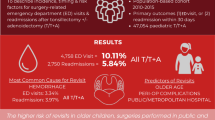Abstract
Pre-operative consent discussion and documentation is an essential process that should follow relevant guidance, and include all serious or frequently occurring risks. We assessed the appropriateness of consent for grommet insertion, tonsillectomy, septoplasty, and hemithyroidectomy, by comparing the risks listed in current consenting practice to published complication data for the relevant operation. 120 consent forms and associated clinic letters were analysed. A literature search identified published complication data for comparison. There was great variation in consent practice for each operation type, and poor correlation with published risk incidence. Only ‘bleeding’ post-tonsillectomy and ‘recurrent laryngeal nerve injury’ post hemithyroidectomy were listed in 100 % of relevant cases. Common and serious complications were frequently omitted from forms. The number and type of risks consented for a procedure significantly differed between consultant and non-consultant staff. The potential requirement for blood transfusion was discussed in only 20 % of tonsillectomy cases. Currently, the pre-operative consent for commonly performed ENT operations does not reflect operative risks. Consenting for surgical complications should be evidence based using published or personal data. A change in the consent process is required to protect patient autonomy and meet both legal and professional body requirements.


Similar content being viewed by others
References
Department of Health (2009) Reference guide to consent for examination or treatment, 2nd edn. Department of Health, London
The Royal College of Surgeons of England Good surgical practice (2008) The Royal College of Surgeons of England, London
General Medical Council Consent: patients and doctors making decisions together (2008) General Medical Council, London
Jeyaseelan L, Ward J, Papanna M, Sundararajan S (2010) Quality of consent form completion in orthopaedics: are we just going through the motions? J Med Ethics 36:407–408
Pearce ((1999) 48 BMLR 118) v United Bristol Healthcare NHS Trust
deVries H et al (2009) International comparison of ten medical regulatory systems. RAND Corporation, Santa Monica
Code de Déontologie Médicale. http://www.conseil-national.medecin.fr/article/le-code-de-deontologie-medicale-915 Accessed 14 Mar 2013
Professional code for physicians in germany. http://www.bundesaerztekammer.de/downloads/MBOengl.pdf Accessed 14 Mar 2013
ENT-UK (2006) Clinical audit and practice advisory group. version of NICE Guidelines for pre-operative tests. ENT-UK, London
Kay DJ, Nelson M, Rosenfeld RM (2001) Meta-analysis of tympanostomy tube sequelae. Otolaryngol Head Neck Surg 124:374–380
Browning GG, Rovers MM, Williamson I, Lous J, Burton MJ (2010) Grommets (ventilation tubes) for hearing loss associated with otitis media with effusion in children. Cochrane database of systematic reviews (online) doi:10.1002/14651858.CD001801.pub3
National prospective tonsillectomy audit final report (2005) The Royal College of Surgeons of England, London
Pinder DK, Wilson H, Hilton MP (2011) Dissection versus diathermy for tonsillectomy. Cochrane Database Syst Rev 16:CD002211
Evans AS, El-Hawrani A, Lodhi A, Thompson A (2003) Lip injury prevention during tonsillectomy. J Laryngol Otol 117:549–550
Bak NB (2010) Accidental tooth avulsion during tonsillectomy. Ugeskr Laeger 24:1611–1612
Heiser C, Landis BN, Giger R, Van Cao H, Guinand N, Hörmann K, Stuck BA (2010) Taste disturbance following tonsillectomy—a prospective study. Laryngoscope 120:2119–2124
Dhiwakar M, Clement WA, Supriya M, McKerrow W (2010) Antibiotics to reduce post-tonsillectomy morbidity. Cochrane Database Syst Rev 7:CD005607
Randall DA, Hoffer ME (1998) Complications of tonsillectomy and adenoidectomy. Otolaryngol Head Neck Surg 118:61–68
Bateman ND, Woolford TJ (2003) Informed consent for septal surgery: the evidence-base. J laryngol otol 117:186–189. doi:10.1258/002221503321192476
Vaiman M, Sarfaty S, Shlamkovich N, Segal S, Eviatar E (2005) Fibrin sealant: alternative to nasal packing in endonasal operations a prospective randomized study. Isr Med Assoc J 7:571–574
The British Association of Endocrine and Thyroid Surgeons. Third National Audit Report (2009) BAETS, London. ISBN 1- 903968-25-9
Wj C (2010) Fifteen years’ experience in thyroid surgery. Ann R Coll Surg Engl 92:541–547
Keulers BJ et al (2008) Surgeons underestimate their patients’ desire for preoperative information. World J Surg 32:964–970
McManus PL, Wheatley KE (2003) Consent and complications: risk disclosure varies widely between individual surgeons. Ann R Coll Surg Engl 85:79–82
Beresford-Cleary NJ, Halliday J, Breusch SJ, Biant LC (2011) Consent process for elective total hip and knee arthroplasty. J orthop surg (Hong Kong) 19:274–278
Murphy K, Shafiq A, Corrigan MA, Redmond HP (2011) A descriptive study of consent documentation. Ir Med J 104:238–240
British Medical Association (2009) Consent tool kit, 5th edn. British Medical Association, London
Chadha NK, Pratap R, Narula AA (2003) Consent processes in common nose and throat procedures. J Laryngol Otol 117:536–539
McDonald SE, Chadha NK, Mills RS (2008) Changing practices in the consent process for nose and throat procedures: a three-year study. J Laryngol Otol 122:1–4
Puwanarajah P, McDonald SE (2010) Changes in surgical consent practices for common otolaryngology procedures: impact of modernising medical careers. J Laryngol Otol 124:899–904
Mistry D, Kelly G (2004) Consent for tonsillectomy. Clin Otolaryngol Allied Sci 29:362–368
Chester V, Afshar (2002). EWCA Civ 724; [2003] QB 356
Code de la santé publique. http://www.legifrance.gouv.fr/affichCode.do;jsessionid=653363A8DA95AEB7D7AAC32C0C914E7B.tpdjo07v_2?cidTexte=LEGITEXT000006072665&dateTexte=20111108 Accessed 14 Mar 2013
Molinelli A, Bonsignore A, Rocca G, Ciliberti R (2009) Medical treatment and patient decisional power: the Italian state of the art. Minerva Med 100:429–434
The charter of fundamental rights of the european union. http://wwweuroparleuropaeu/charter/default_enhtm. Accessed 14 Mar 2013
Simonsen AR, Duncavage JA, Becker SS (2010) A review of malpractice cases after tonsillectomy and adenoidectomy. Int J Pediatr Otorhinolaryngol 74:977–979
Stevenson AN, Myer CM 3rd, Shuler MD, Singer PS (2012) Complications and legal outcomes of tonsillectomy malpractice claims. Laryngoscope 122:71–74. doi:10.1002/lary.22438
Lavelle-Jones C, Byrne DJ, Rice P, Cuschieri A (1993) Factors affecting quality of informed consent. BMJ 306:885–890
Mahadevan D, Gupta S (2009) Consent for orthopaedic surgery: patient comprehension. Clin Gov 14:20e23
Conflict of interest
None.
Author information
Authors and Affiliations
Corresponding author
Rights and permissions
About this article
Cite this article
Smith, M.E., Lakhani, R. & Bhat, N. Consenting for risk in common ENT operations: an evidence-based approach. Eur Arch Otorhinolaryngol 270, 2551–2557 (2013). https://doi.org/10.1007/s00405-013-2464-6
Received:
Accepted:
Published:
Issue Date:
DOI: https://doi.org/10.1007/s00405-013-2464-6




